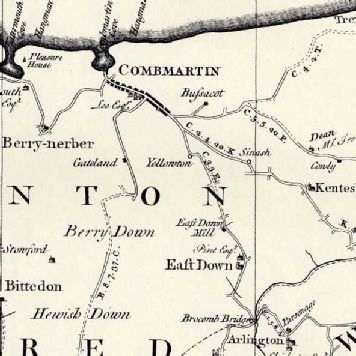East Down before 1700

The earliest evidence of settlement at East Down is the tumuli sited near Shortecombe above the village
This map image is of the East Down area on Donn's one inch to the mile survey of 1765
The Church
Tucked away off the lane and dating back to the 1200s, the Church of John the Baptist is a Grade 2 listed building with a wealth of unusual historical features. The 16th Century font and rare carvings make the church an interesting and unusual feature of the village full of history and well worth a visit.
The Manor House…
Although the actual date of origin is not known, part of the existing Manor House dates back to 1577. A date stone can be found on the front elevation, although this was not its original location as the present front was built in the 17th century, with some wings added in the 18th. Some of the principal rooms still have Elizabethan or Jacobean panelling
The Civil war…
During the English Civil War, records show that 'Mr Pine of East Down was an ardent Royalist' and his memorial can be seen on the south wall inside the church. The Royalist sympathisers found opposing forces not far away, for a battle was fought at Mattocks Down (which lies between Stonecombe and the A3123) and a skirmish occurred in the vicinity of the church. Despite a considerable amount of repair and restoration the tower still shows evidence of damage sustained in the Civil War. At least one bullet mark can be seen just below the battlement on the east side.
The manor house didn’t escape either. Damage caused during the Civil War can still be seen on parts of the building, and there are secret hiding places in the house and grounds from that period. In more recent times several famous people have stayed at the manor, amongst them politicians like Baroness Thatcher and Sir Keith Joseph, as well foreign dignitaries.
The Church House…
The building on the north side of the churchyard is a rare example of a Church House. Every parish originally possessed one, but only those built within church grounds remain today. Their origin dates back to Saxon times, when guilds were established within parochial communities, each charged with a specific parish responsibility and a duty to raise collections for that purpose. The diverse industries of the countryside such as malting and milling can be seen in the buildings around the area, though rarely, of course, in their current uses